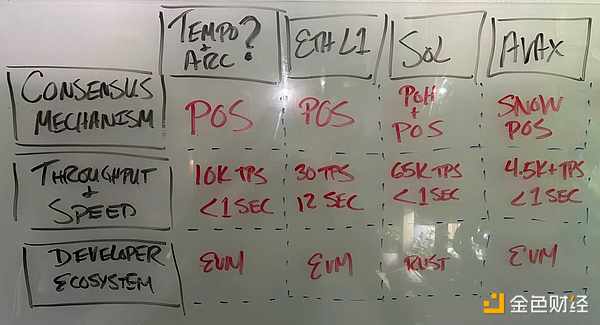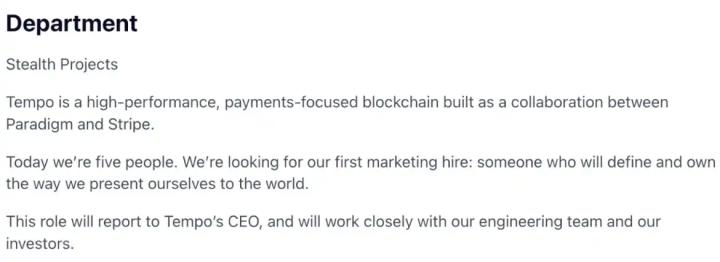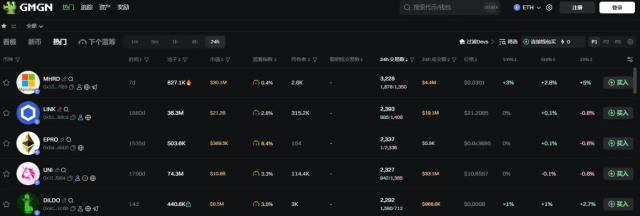Author: 0xWorkhorse, Compiled by: Shaw, Jinse Finance
Within just a few days, two financial technology giants announced the construction of their own Layer 1 blockchains, bypassing numerous existing solutions. First, Stripe launched Tempo - a Layer 1 blockchain optimized for payments and EVM-compatible. Circle followed suit, introducing Arc, their own network focused on stablecoins and EVM compatibility.
 With heavyweight projects like Ethereum, Solana, and Avalanche already providing robust scalability and mature developer tools, why are these companies starting from scratch? Based on signs of acquisitions, regulatory changes, and industry reactions, there are four strategic driving factors: control, value capture, compliance, and the trillion-dollar stablecoin opportunity.
With heavyweight projects like Ethereum, Solana, and Avalanche already providing robust scalability and mature developer tools, why are these companies starting from scratch? Based on signs of acquisitions, regulatory changes, and industry reactions, there are four strategic driving factors: control, value capture, compliance, and the trillion-dollar stablecoin opportunity.
Frankly, I believe they could have utilized existing tools - I've used quite a few myself. These solutions seem obvious to me, so whether we like or dislike this move, it's worth understanding why they're doing it. Is this purely about money, or are there deeper technical and logical considerations?
Official Announcement: Tempo and Arc Enter the Layer 1 Domain
To understand these moves, let's look at what Stripe and Circle have been quietly building - and why now.
Stripe's Tempo
On August 11th, Stripe partnered with Paradigm, one of the most influential investment firms in the crypto space, to create Tempo, a high-performance L1 payment platform optimized for stablecoin infrastructure. Previously, Stripe acquired Bridge for $1.1 billion in October 2024 to obtain stablecoin technology and Privy in June 2025 to acquire wallet infrastructure, including account abstraction and fee-free transactions.
In my view, their development trajectory is clear: Stripe is building a fully integrated payment system from wallet to settlement layer.
Circle's Arc
Just a day later, Circle announced the launch of Arc, simultaneously reporting Q2 revenue of $658 million and USDC circulation exceeding $65 billion. Arc is EVM-compatible, uses USDC as its native fee token, and includes a built-in stablecoin forex engine, sub-second settlement, optional privacy features, and direct integration with the Circle platform. The public testnet is expected to launch this fall, with Arc set to become a pillar for stablecoin payments, forex, and capital markets.
The launch of these products came after the GENIUS Act in July 2025, which clarified U.S. stablecoin rules and sparked a fintech arms race to build compliant, enterprise-grade blockchain payment systems.
Why Launch: Four Shared Driving Forces
 Theoretically, building L2 networks or expanding existing chains would be cheaper, faster, and lower risk. As mentioned, the demands of Tempo and Arc could likely be met.
Theoretically, building L2 networks or expanding existing chains would be cheaper, faster, and lower risk. As mentioned, the demands of Tempo and Arc could likely be met.
However, Stripe and Circle have four motivations that existing payment channels may not fully satisfy.
1. Designed Specifically for Stablecoins
Existing Layer 1 networks are generic. Tempo and Arc are designed specifically for stablecoin settlement and payments. Stripe can directly embed Bridge's issuance tools and Privy's fee-free wallet technology into Tempo to enable instant, low-cost mass transactions. Circle uses USDC as fees and integrates a native forex engine, enabling real-time cross-currency settlement without relying on external oracles.
As Circle CEO Jeremy Allaire said, this is to "accelerate interest in building on stablecoins" - and generic chains cannot guarantee enterprise-grade speed, uptime, and privacy without compromise.
2. Vertical Integration and Value Capture
Using third-party chains means paying fees, experiencing congestion, and being subject to governance decisions beyond your control.
By owning the base layer, Stripe can fine-tune consensus mechanisms, block times, and fees based on merchant transaction volume, and potentially introduce token economics or exclusive merchant privileges.
Meanwhile, Circle can ensure Arc is fully compatible with its platform while capturing more value from USDC's dominance.
3. Compliance, Security, and Regulatory Flexibility
After the GENIUS Act, stablecoins face higher compliance requirements. Tempo and Arc can embed KYC, privacy controls, and auditable settlement processes from the start - which is much easier than retrofitting these features onto decentralized public chains.
Stripe's private nature means it can iterate without shareholder opposition; Circle can align Arc's governance with its regulated status.
That said, Avalanche recently addressed these needs by launching eERC, a privacy-focused token standard compliant with institutional requirements.
4. Innovation Beyond Existing Limitations
Both companies can develop features not optimized in generic L1 networks:
Tempo: Instant merchant settlement, streaming micropayments, yield-bearing balances combined with fiat currency.
Arc: Autonomous privacy protection for capital markets, native forex tools, programmable settlement.
These features will create platform effects - Tempo might become the default choice for Stripe merchants; Arc might become the preferred platform for USDC-supported applications.
This represents a "billion-dollar opportunity" at the L1 valuation level.
Summary
If Tempo and Arc succeed, this shift will be significant. Faster, cheaper payment methods might divert business from payment card networks, micropayments and real-time forex trading could become mainstream, and stablecoin-native Layer 1 protocols might consolidate market share - even as Layer 1 network fragmentation continues.
From an industry health perspective, I'm not entirely enthusiastic about this move, but I understand the industry will only become more efficient over time. Ideally, this efficiency would be driven by existing and emerging participants we've supported for years - but we can't always determine who will win.
The crypto community's skepticism is justified, and I'm skeptical too - but I also understand that for new institutional entrants, the scale of opportunity is enormous, so they'll seize it every time - that's their style.
For Stripe and Circle, these are not superfluous moves - but carefully planned positioning aimed at controlling the future of digital payments.






